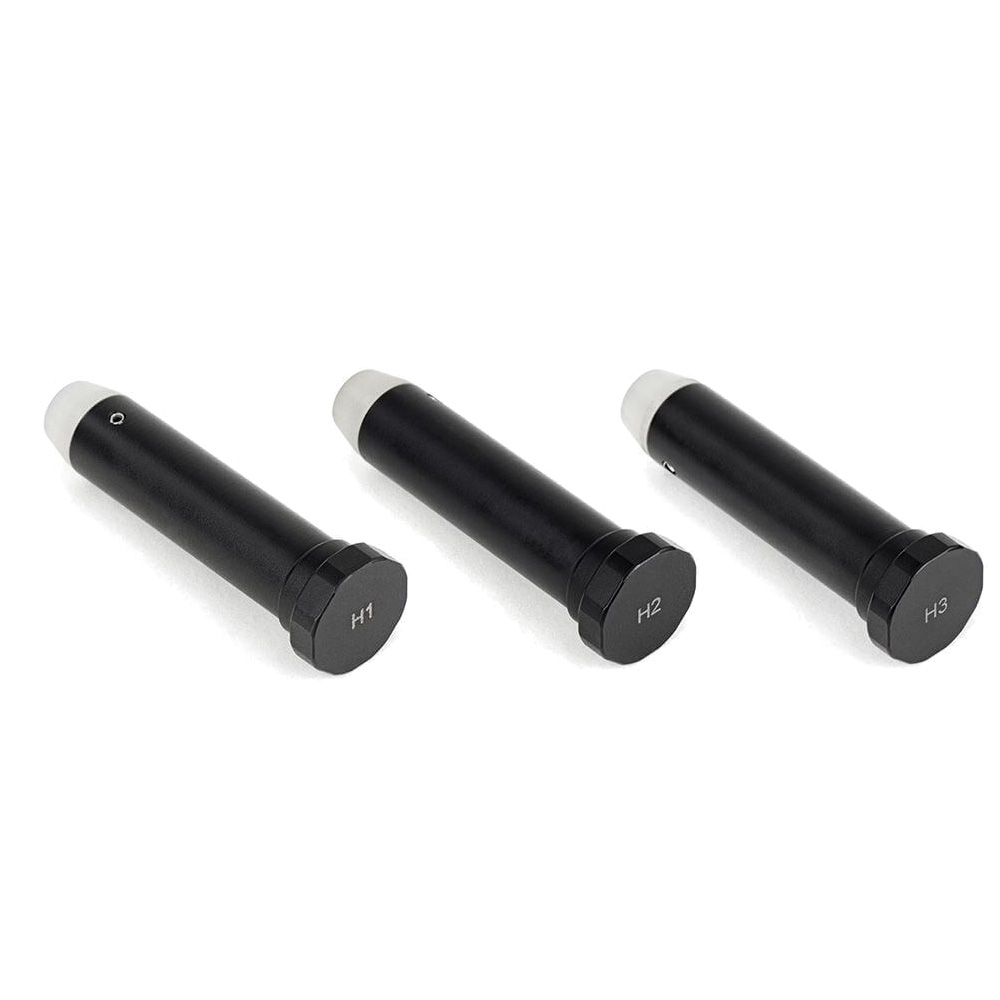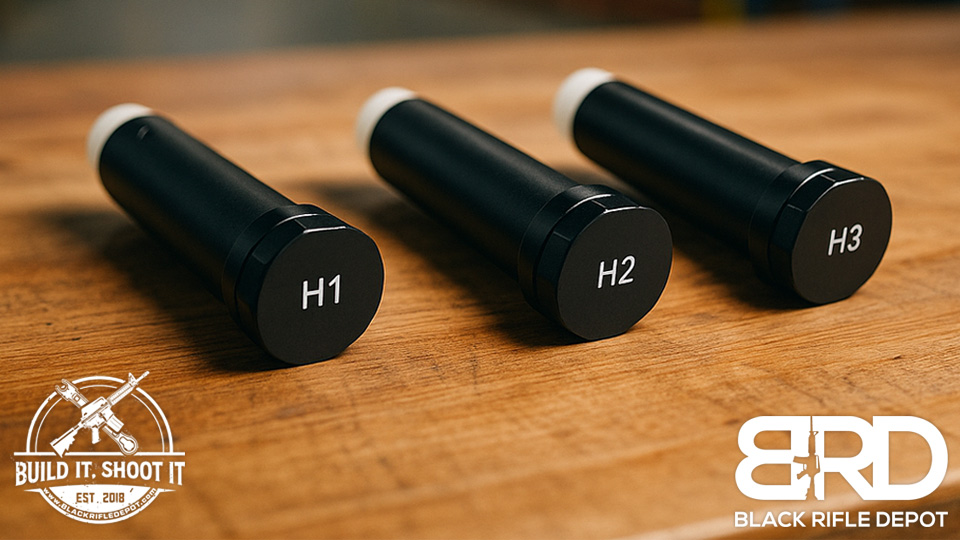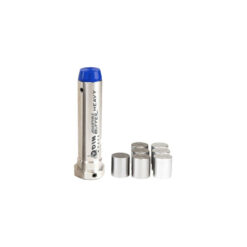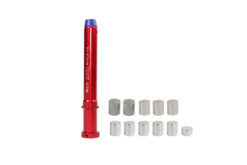AR-15 Parts
AR-15 Buffer Weights: Choosing the Right Setup for a More Reliable Rifle
Table of Contents
A well-tuned AR-15 doesn’t happen by chance. It comes from understanding how each component influences performance, reliability, and shooting comfort. One of the most important—yet often overlooked—parts of a dependable rifle is the buffer system. AR-15 buffer weights play a key role in controlling recoil, cycling speed, and overall reliability.

In this guide, we break down the differences between standard buffers, H1- and H2-heavy buffers, and adjustable buffer weights. You’ll learn how each influences gas pressure, recoil impulse, and long-term durability so you can choose the proper setup for your rifle. By the end, you’ll know which buffer configuration will deliver the smoothest and most reliable shooting experience.
What AR-15 Buffer Weights Do and Why They Matter
Inside your rifle’s receiver extension, the buffer and spring control how the bolt carrier group travels. When the rifle fires, gas drives the carrier rearward. The buffer slows this movement, absorbs energy, and then pushes the carrier forward to chamber the next round, creating a balanced cycle that keeps the rifle operating the way it was designed.
If the buffer weight isn’t correctly matched to the gas system, your rifle may experience excessive recoil, harsh cycling, premature wear, inconsistent ejection, or short-stroking. Choosing the correct AR-15 buffer weight ensures the rifle cycles smoothly and maintains consistent reliability, especially as more shooters run modern barrels, suppressors, and performance-focused components.
Standard Carbine Buffers: Light and Fast
A standard carbine buffer weighs around 3.0 ounces and contains three internal steel weights. It works well for many out-of-the-box 16-inch rifles with traditional gas systems. However, modern rifles often run hotter due to shorter barrels, aggressive gas systems, or efficient muzzle devices, making the standard buffer less ideal for shooters seeking smoother, more controlled performance overall.
When paired with an overgassed system, the standard buffer allows the bolt to move too quickly, resulting in a snappier recoil impulse and increased wear on internal components. While it still functions well for undergassed rifles or low-pressure ammunition, most builders eventually upgrade to a heavier option to improve reliability, tune cycling, and reduce felt recoil.
H1 Heavy Buffers: A Balanced Improvement
An H1 buffer weighs roughly 3.8 to 4.0 ounces and contains a mix of tungsten and steel weights. The added mass helps slow bolt velocity, reducing recoil and improving overall control. This makes it an excellent choice for rifles that feel slightly overgassed or eject brass aggressively forward.
If your rifle feels sharp during recoil, cycles quickly with hot ammunition, or ejects brass toward the 1–2 o’clock position, an H1 buffer often brings the system back into balance while still maintaining reliable cycling across various ammo types.
H2 Heavy Buffers: Ideal for Suppressed or Overgassed Rifles
The H2 buffer weighs about 4.6 to 4.7 ounces and contains two tungsten weights for additional mass. It has become one of the most common upgrades for modern AR-15 setups, especially rifles with short barrels or suppressors.
Suppressors increase backpressure and raise bolt carrier velocity. An H2 buffer helps restore smooth cycling by slowing down the action, reducing gas blowback, and improving component longevity. It’s also a strong match for aggressive carbine gas systems or high-pressure ammunition.
Adjustable Buffer Weights: Maximum Tuning Flexibility
Adjustable buffers offer the most customization. By swapping internal weights, you can configure the buffer to behave like a standard, H1, H2, or even heavier setup. This flexibility makes adjustable buffers ideal for shooters who switch between suppressed and unsuppressed, run multiple ammo types, or want precise control for precision or competition rifles, especially when fine-tuning recoil impulse or improving overall cycling consistency.
Paired with an adjustable gas block, adjustable buffers give shooters the highest level of tuning control, allowing the rifle to operate more smoothly and efficiently.
Choosing the Right Buffer Weight for Your AR-15
Selecting the correct buffer weight depends on your barrel length, gas system, muzzle device, and suppressor use. Below is a clear, easy-to-read chart that outlines recommended buffer weights for standard AR-15 configurations, helping shooters choose the most reliable setup and avoid common cycling issues that can arise when pairing modern components with the wrong buffer mass.
Recommended Buffer Weight Chart
| AR-15 Setup | Recommended Buffer Weight | Notes |
|---|---|---|
| 16″ Carbine Gas | H1 | Helps smooth the sharper cycling typical of carbine gas systems. |
| 16″ Mid-Length Gas | Standard or H1 | Standard works well; H1 softens recoil with hotter loads. |
| 14.5″ Mid-Length Gas | H1 | Adds stability for slightly shorter dwell time. |
| 14.5″ Carbine Gas | H2 | Often runs hot; H2 slows bolt speed for smoother cycling. |
| 10.5″–12.5″ Unsuppressed | H2 | Ideal for managing aggressive cycling in short barrels. |
| 10.5″–12.5″ Suppressed | H2 or H3 | Suppressors increase pressure; heavier buffers restore balance. |
| Any Barrel Length Suppressed Only | H2 | Reduces gas blowback and bolt speed under sustained fire. |
| Precision or Competition Builds | Adjustable Buffer | Offers the most tuning flexibility for recoil and timing. |
Understanding Your Ejection Pattern
Ejection angle gives quick insight into whether your rifle is properly balanced:
- Brass ejecting at 1–2 o’clock means the rifle is overgassed
- Brass ejecting at 3–4 o’clock is ideal
- Brass ejecting weakly at 5 o’clock indicates undergassing
Always test your buffer selection with the ammunition you use most.
How Buffer Weight Affects Recoil and Reliability
Buffer weight directly influences recoil impulse and system timing. A heavier buffer slows the bolt carrier, softens recoil, and reduces wear inside the receiver. This leads to a flatter-shooting rifle with improved control and longevity.
A properly tuned buffer also helps vent excess gas before extraction begins, which reduces fouling and gas blowback—particularly important when using a suppressor. Buffer tuning ensures consistent performance across varying weather conditions, ammo types, and shooting scenarios.
Signs You Should Adjust Buffer Weight
Your rifle will show clear signs when the buffer weight needs adjustment.
Too Light
- Harsh recoil
- Forward ejection (1–2 o’clock)
- Bolt-over-base malfunctions
- Fast, aggressive cycling
- Excess wear on the bolt catch
Too Heavy
- Weak ejection
- Short-stroking
- Failure to lock back on empty
- Feeding issues with lower-pressure ammo
Finding the right weight is about balance, not simply choosing the heaviest buffer available.
Pairing Buffer Weights With Other AR-15 Accessories
The buffer is part of a larger interconnected system. For the smoothest performance, pair your buffer choice with quality components such as:
- Adjustable gas blocks to regulate gas flow
- Enhanced buffer springs for consistent tension
- Quality bolt carrier groups
- Properly sized muzzle devices
When combined, these upgrades significantly improve timing, recoil control, and overall reliability.
FAQ: AR-15 Buffer Weights
What is the purpose of AR-15 buffer weights?
Buffer weights control bolt carrier speed, reduce recoil, and improve timing inside the AR-15 system. Choosing the right weight increases reliability and reduces wear.
How can I tell if my buffer weight is incorrect?
Forward ejection, harsh recoil, or fast cycling indicate a buffer that’s too light. Weak ejection or short-stroking indicates a buffer that’s too heavy.
Should I use a fixed or adjustable buffer?
Fixed buffers like H1 and H2 offer reliable, simple performance. Adjustable buffers are ideal for shooters who frequently change ammo or run both suppressed and unsuppressed.
Do suppressed rifles require heavier buffers?
Most do. Suppressors increase gas pressure and bolt speed, making an H2 buffer the most commonly recommended option.
Are heavier buffers always better?
No. Over-buffering can hurt reliability. The best buffer weight matches your gas system, barrel length, and shooting conditions.
Choose the Right Buffer Weight for a More Reliable Rifle
Your AR-15’s buffer weight plays a significant role in how the rifle cycles, how it handles recoil, and how reliably it runs across different shooting conditions. Whether you’re tuning a standard 16-inch build, dialing in a short-barreled rifle, or optimizing a suppressed setup, choosing the right buffer helps ensure smoother operation and longer-lasting components.
A properly balanced buffer system reduces wear, softens recoil, and delivers a more controlled, predictable shooting experience. When you match your buffer weight to your rifle’s gas system, ammunition, and intended use, you set yourself up for better performance every time you hit the range.
If you’re looking to upgrade your AR-15 buffer setup or want to fine-tune your rifle with the best AR-15 parts available, head to Black Rifle Depot. You’ll find quality buffers, springs, gas system components, and other essential AR-15 accessories to build or upgrade your rifle with confidence.
For additional resources, check out our Rumble Channel.






